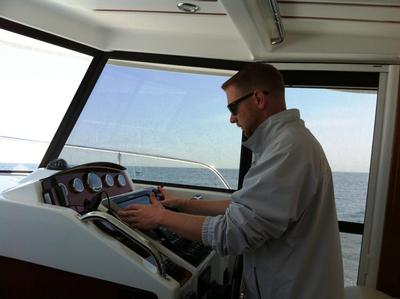An interview with Patrick Hopkins, Technical Coordinator for The Greatest Loop
Posted By: Maryline O'Shea | June 19, 2012

1- Patrick, what is your role in The Greatest Loop adventure?
As part of the Annapolis Yacht Sales team, I helped commission the vessel when she arrived from France in March. My job then consisted in making sure the boat was outfitted properly for her journey, and today I’m in charge of technical assistance to her different crews until she completes the great loop trip.
When the boat returns to Annapolis, our office will be listing the boat for sale and showing her off at the Baltimore TrawlerFest (in September) and at the Annapolis Powerboat Show (October 11-14).
2- What type of spare kits and parts do you have on board?
We took onboard several spare kits for the generator and the engine (including filters and belts), engine oil as well as a spare prop and complete tool kit. The Plano tool box includes:
94 Piece Mechanic Tool Set
Craftsman 2.5 Gallon Wet/Dry Vac w/ extra nozzle
Craftsman Multimeter
1 Craftsman Flashlight
2 Dorcy LED Flashlights
1 Leatherman
11 Piece Combo Wrench Set 1 SAE 1 METRIC
6 Piece Screwdriver Set
Razor Knife
2 Slotted Cabinet Drivers one Phillips one Flat
1 Pair Regular Plyers
1 Pair Long Nose Plyers
1 Adjustable Wrench
Mini Hacksaw
File for Hacksaw
Mechanics Rags
Silicone Rubber
Allen Key Set 1 SAE and 1 Metric
Ball Peen Hammer
WD-40
Filter Wrench
3- Is there anything that has been missing?
We haven’t noticed anything missing yet!
4- What have you gotten the most questions on so far?
From our different crews, the new chart plotter (Raymarine’s e125) was a bit foreign to our captains at first because Raymarine revamped their user interface It’s naturally the tool you rely on the most when navigating, therefore a critical one to learn. Just like any new technology, it takes some adjusting. I have been using Raymarine instruments from years, and on my first trip down from Annapolis to Norfolk “pre-loop” it took me a few minutes to get acquainted with the e125's new menu structure. After browsing the menus, I got the hang of it and it’s actually very intuitive!
We’ve often received questions from our followers on how to lower the mast, which is really simple on the Swift 34. You need to undo the top bolt at the base, loosen the lower bolt and then walk the mast down to let it rest on the stanchions. You need to move the dinghy on its side in order to make room for the mast.
5- Tell us about the break-in period and service stops for the engine.
We’ve been instructed by Cummins to let the engine ride at varying RPMS at low speeds between 1000 and 2000 in increments of 200 (all the way up, and then back down) to help the rings settle; we were also advised not to push the engine too hard during the break-in period which lasts for about 300 hours.
We scheduled the first service at 50 hours in NY. The Cummins technician changed all fluids (oil, transmission) and filters. During the full inspection, we typically look for metal shavings in the oil, but did not find any (that’s a good sign!). All was in great shape and the following services was scheduled for 150 hours later.
The following service was therefore taken care of in Chigcao at about 200 hours. We conducted the second service just before entering the Mississippi leg because it was most the practical place and fitted the schedule well at just about 200 hours. There again oil and filters were changed, and a full inspection was conducted by a Cummins technician.
The next service is expected in another 150 hours or so; by that time we should be somewhere in the Gulf of Mexico.
6- How did you find the supplier who fixed the prop?
As soon as we learned of the incident, I did an online search, looking for someone established with positive reviews in the vicinity of Chicago. Within 5 minutes of my leaving a message with Airmarine, a gentleman named Jerry Gravesen called back. I was very impressed by the quick turnaround (5 days!) and the knowledge of their staff. We shipped the damaged prop from Michigan, and in less than a week, got our reconditioned prop back while we passed through Chicago.
On a side note, it appears the propeller hit hard bottom; all the blades were bent back, however there was no scratches which suggests a quick “hit” – fairly unusual, according to Jerry. Probably was not a deadhead in the end. But we’ll never know for sure.
7- You were on the first leg from Annapolis to New York City, how did the boat handle in the ocean?
The boat did phenomenal. I didn’t quite expect that. There was a 3 to 5 beam swell on the first day out of Cape May, and the Swift 34 did not dip & dive. The next day, from Atlantic City to NYC we had both beam swell and 3 to 4-ft ocean waves at the bow; while the mix wasn’t all too comfortable, the boat never felt unsafe.
8- How do you feel about being part of The Greatest Loop project?
It's been a great experience; I only wish I could have spent more time on the boat! I've enjoyed using my past experience and working with our team at Annapolis Yacht Sales and with Beneteau to get the boat ready.
When we finish the Loop, I hope we'll take the Swift 44 on a fun project next. She is my favorite in the Swift lineup and would make a fantastic liveaboard.